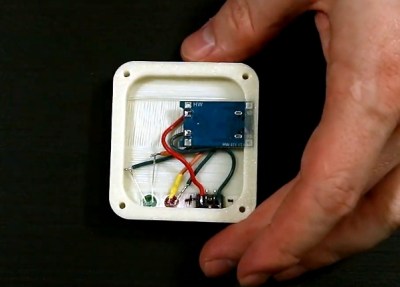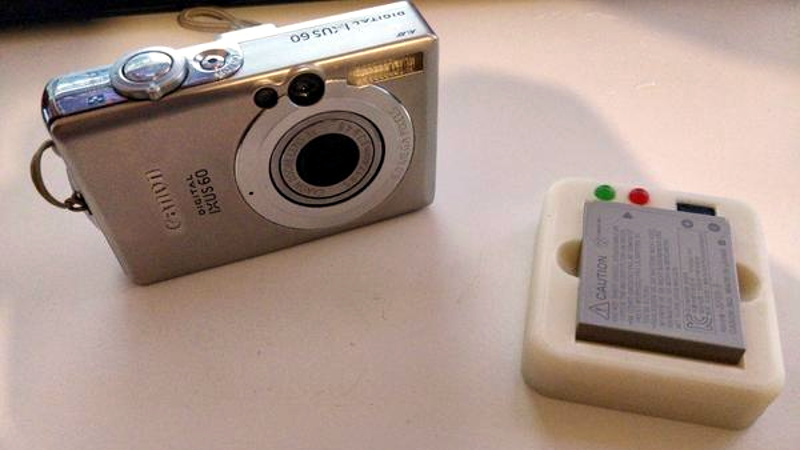One of the most appealing aspects of USB-C is that it promises to be a unified power delivery system. You’ll no longer need to have a separate power cords for for your phone, camera, and laptop; physically they’ll all use USB-C connectors, and the circuitry in the charger will know how much juice to send down the line for each gadget. But in reality, we’ve all got at least a few pieces of older equipment that we’re not about to toss in the trash just because it doesn’t support the latest USB spec.

Case in point, the old Canon camera that [Purkkaviritys] modified to take infrared pictures. Instead of abandoning it, he decided to make a custom USB-C charger for its NB-4L batteries. Since they’re just single cell 3.7 V lithium-ions, all he had to do was wire them up to the ubiquitous TP4056 charger module and design a 3D printed case to hold everything together.
He did go the extra mile and replace the SMD charging indicator LEDs on the PCB with 5 mm LEDs embedded into the 3D printed enclosure, though you could certainly skip this step if you were in a hurry. We imagine if you print the enclosure in a light enough color, you should be able to see the original LEDs glowing through the plastic.
This project is yet another example of how incredibly useful the TP4056 module really is. If there’s even a chance you might want to build a rechargeable gadget in the near future, you should have a few of these cheap boards ready to go in the parts bin.
















Is there a dirt cheap USB charger module that will do three NiMH cells in series?
Its not in series, and its not 3 cells but it is USB and it is relatively cheap. The IKEA VINNINGE USB battery charger.
Well then that’s useful for converting one of those Harbor Freight LED lights to be rechargeable. https://www.harborfreight.com/ultra-bright-led-portable-worklightflashlight-63878.html
Lots of room inside for a charging circuit.
If I would do such a conversion, I would try to convert it to LiIon anyway. I hate the high self discharge of most NiMH batteries.
Had the same issue. Get eneloop batteries, they are worth it
I am using a Li-ion charger LTC4054 as a trickle charger for 3x NiMH backup battery for my LED clock project.
There is a 3 cell battery holder at the base of the CallerID case I am re-purposing.
The charger charges to 4.2V and it would start a new cycle when the battery drops below 4.05V recharge threshold.
4.2V/3 = 1.4V and 4.05V/3 = 1.35V per cell
So this is only good for keeping some charge on the NiMH battery pack, but never going to fully charge them.
I have set the max charge current to 50mA which is the lower limit on the chip. I would rather worry about NiMH leaking than a LiPo pack catching fire hooked up to a charger long term.
You probably need to allow for headroom of at least 1.6V per cell to reach full charge. i.e. more than 4.8V USB has a rather loose voltage spec and never guaranteed to be 5.0V or more, so don’t expect to without a switch somewhere. Her lies the problem as the output ripples can exceed the delta V for charge termination for NiMH that you are monitoring. Not an easy task as I have tried and learnt.
hmmm… I wonder how long it will take before we have USB-D..
Because you can never have too much power and you cannever go fast enough. And to be honest the current size of the connecter can be at least halved in all directions and the number of contact should be trippled just for the fun of it and to make sure that there is at least one contact non functional and hard to find and fix. And ohh.. the cable that attaches to it, should be much thicker and bulkier and very difficult to bend, so that it can apply maximum forces to the fiddly connector that the USB-D standard will introduce.
Sorry for my sarcasm, I had to let it out.
I totally get you. USB C + USB 3.x + alternative functions is a mess.
USB 4 is supposed to fix this: same USB C connector, but 40Gbps i think. And it can work with both synchronous transmission (say a monitor) and asynchronous (say a disk) at the same time in the same data stream. So no more stupid switch ICs that actually disconnect the port wires and connect them to something else like HDMI.
I hope it will be better.
40GB/s ? Do they include optical fibers into the next USB spec.?
Small b(its) not big B(ytes) 8X difference.
You can have enough power to charge your laptop. What else do you have in mind? Are you planning on using your USB charger for arc welding? Maybe you can write it up for us.
Not sure if everyone knows, but you can buy these type of boxes to charge camera batteries from USB for pretty much any model.
I found them a lot better than the camera charger. Charges 2 at a time, from a USB port which is more common and can use the power bank too. Plus lighter and cheaper.
What is the point of this comment? Who is suggesting you use the TP4056 for small batteries?
FYI: Canon NB-4L 760mAh 3.7V Li-Ion Battery So max charging current should be 760mA. Not 1A
So you think that’s not a problem?
As for your question. This is the context. HaD made a blanket suggestion without the warning I gave. You think the maker crowd would even know enough to check?
>This project is yet another example of how incredibly useful the TP4056 module really is. If there’s even a chance you might want to build a rechargeable gadget in the near future, you should have a few of these cheap boards ready to go in the parts bin.
The NB-4L has a thermistor, (third connection) but the TP4056 modules I have seen don’t have a thermistor sense input, are they typically clever enough not to need this? I like my Canon 900Ti, still use it despite getting a later higher resolution camera. Titanium case takes a lot of abuse!
The TP4056 IC has a TEMP sensing pin (pin 1) so it shouldn’t be too tricky to add the feature.